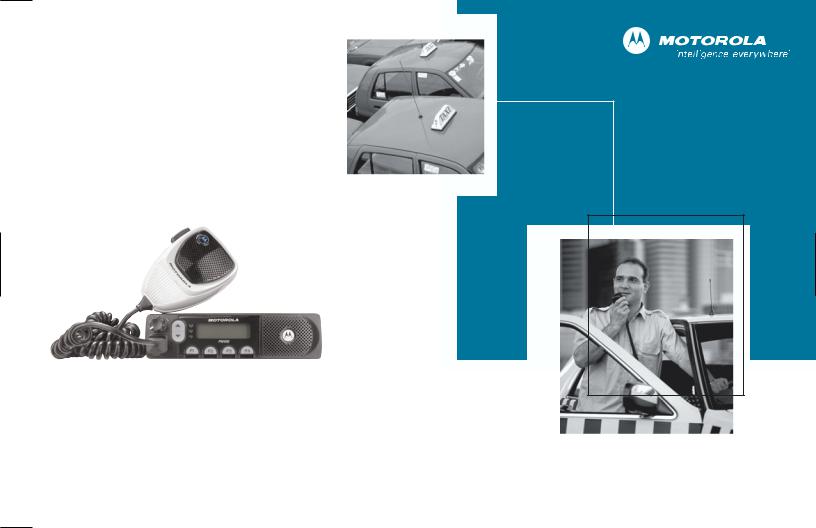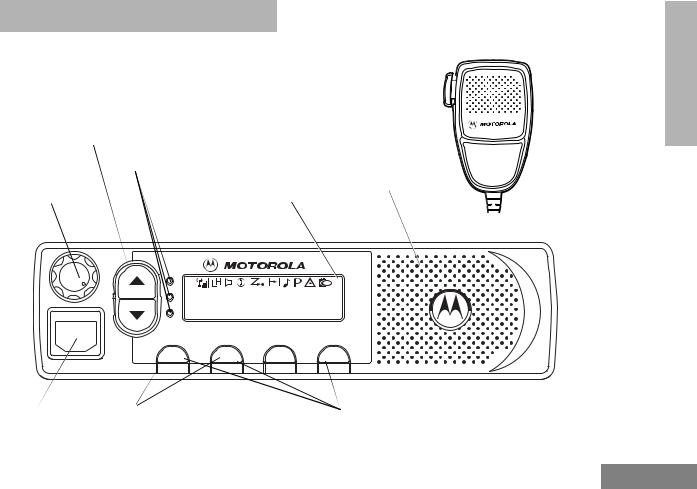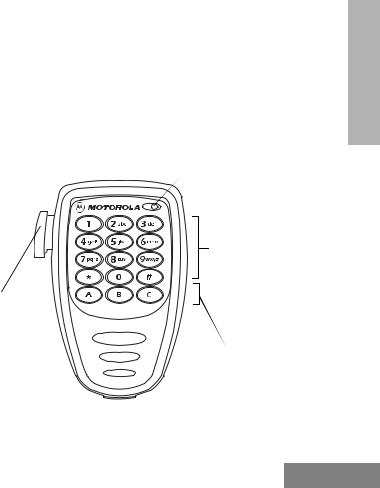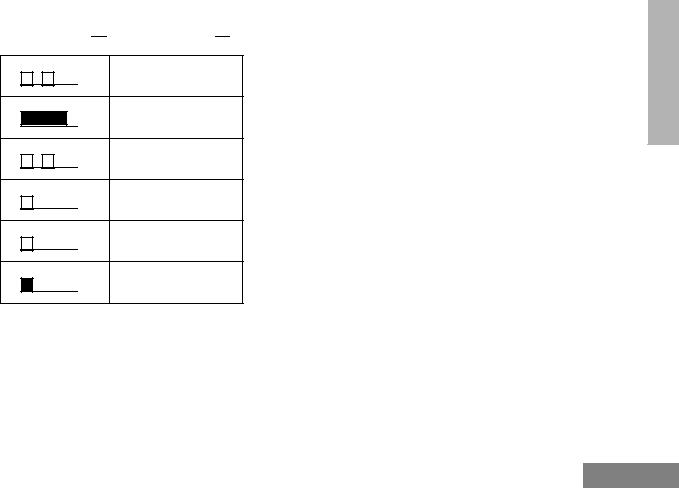Motorola PM400 User Manual

PM400™
Commercial Series
Two-Way Radio User Guide
Manuel de l'utilisateur
de la radio bidirectionnelle
COMPUTER SOFTWARE
COPYRIGHTS
The Motorola products described in this manual may include copyrighted Motorola computer programs stored in semiconductor memories or other media. Laws in the United States and other countries preserve for Motorola certain exclusive rights for copyrighted computer programs including, but not limited to, the exclusive right to copy or reproduce in any form the copyrighted computer program. Accordingly, any copyrighted Motorola computer programs contained in the Motorola products described in this manual may not be copied, reproduced, modified, reverse-engineered, or distributed in any manner without the express written permission of Motorola. Furthermore, the purchase of Motorola products shall not be deemed to grant either directly or by implication, estoppel, or otherwise, any license under the copyrights, patents or patent applications of Motorola, except for the normal non-exclusive license to use that arises by operation of law in the sale of a product.

CONTENTS
Computer Software Copyrights . . . inside cover
Safety . . . . . . . . . . . . . . . . . . . . . . . . . . . . . . 5
Product Safety and RF Exposure
Compliance . . . . . . . . . . . . . . . . . . . . . . . . . 5
Introduction . . . . . . . . . . . . . . . . . . . . . . . . . 7
Conventional Radio Systems . . . . . . . . . . . . 7 Trunked Radio Systems . . . . . . . . . . . . . . . . 7 LTR Trunked Systems . . . . . . . . . . . . . . . 7 PM400 Radio Features . . . . . . . . . . . . . . . . . 8 Radio-Wide Features . . . . . . . . . . . . . . . . 8 LTR Trunked Features . . . . . . . . . . . . . . . 8 Conventional Signaling Features . . . . . . . 8
Radio Overview . . . . . . . . . . . . . . . . . . . . . 11
LED Indicators. . . . . . . . . . . . . . . . . . . . . . . 12 Display . . . . . . . . . . . . . . . . . . . . . . . . . . . . 12 Optional Enhanced Keypad Microphone
(RMN5029) . . . . . . . . . . . . . . . . . . . . . . . . 13 Indicator Tones . . . . . . . . . . . . . . . . . . . . . . 15 Programmable Buttons . . . . . . . . . . . . . . . . 16 Menu Buttons . . . . . . . . . . . . . . . . . . . . . . . 19 Menu Button. . . . . . . . . . . . . . . . . . . . . . 19 Menu Scroll Buttons. . . . . . . . . . . . . . . . 19 Navigate the Menu . . . . . . . . . . . . . . . . . 19
Getting Started . . . . . . . . . . . . . . . . . . . . . .21
Turn the Radio On or Off . . . . . . . . . . . . . . .21 Adjust the Volume . . . . . . . . . . . . . . . . . . . .21 Select an LTR Channel/Talkgroup . . . . . . . .22 Select a Conventional Channel . . . . . . . . . .22 Receive a Conventional or LTR Call. . . . . . .22 Monitor . . . . . . . . . . . . . . . . . . . . . . . . . . . . .23
Silent Monitor. . . . . . . . . . . . . . . . . . . . . .23 Open Squelch Monitor. . . . . . . . . . . . . . .23 Transmit an LTR Call . . . . . . . . . . . . . . . . . .24 Transmit a Conventional Call . . . . . . . . . . . .24 Repeater or Talkaround Mode . . . . . . . . . . .25 Revert Memory Channel (1 & 2). . . . . . . . . .25 Store Memory Channel (1 & 2). . . . . . . . . . .25 Home Revert AutoKey (1 & 2) . . . . . . . . . . .26 Set Local or Distance Mode . . . . . . . . . . . . .26 VOX Operation . . . . . . . . . . . . . . . . . . . . . . .26 Program PL/DPL Codes . . . . . . . . . . . . . . . .27
Radio Calls . . . . . . . . . . . . . . . . . . . . . . . . .29
Selective Radio Inhibit . . . . . . . . . . . . . . . . .29 Receive a Selective Call
(Conventional Operation Only) . . . . . . . . . .29 Send a Selective Call
(Conventional Operation Only) . . . . . . . . . .30 Receive a Call Alert™ Page
(Conventional Operation Only) . . . . . . . . . .30
1
CONTENTS
English

CONTENTS
Send a Call Alert Page
(Conventional Operation Only) . . . . . . . . . .31 Repeater Access . . . . . . . . . . . . . . . . . . . . .31 Radio Check . . . . . . . . . . . . . . . . . . . . . . . . .32 Emergency Alerts . . . . . . . . . . . . . . . . . . . . .32 Send an Emergency Alert. . . . . . . . . . . . . . .32 Clear an Emergency Alert. . . . . . . . . . . . . . .32
Scan . . . . . . . . . . . . . . . . . . . . . . . . . . . . . . .33
Talkback . . . . . . . . . . . . . . . . . . . . . . . . . . . .33 Start System Scan . . . . . . . . . . . . . . . . . . . .34 Stop System Scan . . . . . . . . . . . . . . . . . . . .34 Start Auto Scan . . . . . . . . . . . . . . . . . . . . . .35 Stop Auto Scan. . . . . . . . . . . . . . . . . . . . . . .35 Delete a Nuisance Channel/Talkgroup. . . . .35
Restore Channels/Talkgroups to the
Scan List. . . . . . . . . . . . . . . . . . . . . . . .36 Edit a Scan List. . . . . . . . . . . . . . . . . . . . . . .36 Add or Delete Channels/Talkgroups in a
Scan List. . . . . . . . . . . . . . . . . . . . . . . . . . .37 Prioritize a Channel/Talkgroup in a Scan
List . . . . . . . . . . . . . . . . . . . . . . . . . . . . . . .38
Phone. . . . . . . . . . . . . . . . . . . . . . . . . . . . . .41
Receive a Phone Call . . . . . . . . . . . . . . . . . .41 Make a Phone Call . . . . . . . . . . . . . . . . . . . .43 Edit the Phone List . . . . . . . . . . . . . . . . . . . .44
Add an Entry . . . . . . . . . . . . . . . . . . . . . . 45
Delete an Entry . . . . . . . . . . . . . . . . . . . . 45
Edit an Entry . . . . . . . . . . . . . . . . . . . . . . 46
Edit Access/Deaccess Codes . . . . . . . . . 47
Tone Preferences. . . . . . . . . . . . . . . . . . . . 49
Tones On/Off . . . . . . . . . . . . . . . . . . . . . . . . 51
Keypad On/Off Tones . . . . . . . . . . . . . . . . . 51
Call Tone Tagging (Conventional
Operation Only) . . . . . . . . . . . . . . . . . . . . . 52
Escalert (Conventional
Operation Only) . . . . . . . . . . . . . . . . . . . . . 53
User Settings . . . . . . . . . . . . . . . . . . . . . . . 55
Set Squelch Level . . . . . . . . . . . . . . . . . . . . 57
Set Power Level. . . . . . . . . . . . . . . . . . . . . . 57
Option Board On/Off . . . . . . . . . . . . . . . . . . 58
Set the Backlight Intensity . . . . . . . . . . . . . . 59
Display the Software Version . . . . . . . . . . . . 59
Warranty . . . . . . . . . . . . . . . . . . . . . . . . . . . 61
Limited Warranty . . . . . . . . . . . . . . . . . . . . . 61
Accessories . . . . . . . . . . . . . . . . . . . . . . . . 65
Antennas . . . . . . . . . . . . . . . . . . . . . . . . . . . 65
Alarm and Accessories . . . . . . . . . . . . . . . . 65
Audio . . . . . . . . . . . . . . . . . . . . . . . . . . . . . . 65
2
English

Cables. . . . . . . . . . . . . . . . . . . . . . . . . . . . . 66
Control Station . . . . . . . . . . . . . . . . . . . . . . 66
Data - CES Wireless Technologies. . . . . . . 66
Mounting . . . . . . . . . . . . . . . . . . . . . . . . . . . 67
Public Address . . . . . . . . . . . . . . . . . . . . . . 67
CONTENTS
3
English

Notes:
CONTENTS
4
English

SAFETY
PRODUCT SAFETY AND RF EXPOSURE COMPLIANCE
!
C a u t i o n
Before using this product, read the operating instructions for safe usage contained in the Product Safety and RF Exposure booklet enclosed with your radio.
ATTENTION!
This radio is restricted to occupational use only to satisfy FCC RF energy exposure requirements. Before using this product, read the RF energy awareness information and operating instructions in the Product Safety and RF Exposure booklet enclosed with your radio (Motorola Publication part number 68P81095C99) to ensure compliance with RF energy exposure limits.
For a list of Motorola-approved antennas, batteries, and other accessories, visit the following web site which lists approved accessories: http://www.motorola.com/cgiss/ index.shtml.
SAFETY
5
English

Notes:
SAFETY
6
English

INTRODUCTION
Your PM400™ radio can operate on both LTR® trunked and conventional radio systems. This radio combines the very latest in two-way technology while delivering outstanding functionality at the touch of a button.
CONVENTIONAL RADIO SYSTEMS
Conventional typically refers to radio-to-radio communications through a single channel. Conventional systems also allow radio users to extend communication coverage by relaying their messages through a repeater. To ensure coordinated use by multiple users, each radio user must monitor the channel or repeater before transmitting to verify that the system is not currently busy.
TRUNKED RADIO SYSTEMS
A trunked radio system allows a large number of users to share a relatively small number of frequencies or repeaters without interfering with each other. The airtime of all the repeaters in a trunked system is pooled, which maximizes the amount of airtime available to
any one radio and minimizes channel/ talkgroup congestion.
Some of the benefits of trunked two-way radio systems are:
•No channel/talkgroup monitoring required prior to transmission
•Improved system access
•Automatic channel/talkgroup selection
•Increased privacy among members of the same group
LTR Trunked Systems
LTR (Logic Trunked Radio) is a transmissionbased trunking protocol developed by the E. F. Johnson Company for primarily single-site trunking applications. In transmission trunking, a repeater is used for only the duration of a single transmission. Once a transmission is completed, that repeater becomes available to other users. This means that a conversation comprised of many transmissions may occur over several different channels/talkgroups within the LTR system. This method of trunking provides system efficiency by making repeaters available to all users after every transmission.
When an LTR trunked radio user wants to communicate with another radio, the user’s
7
INTRODUCTION
English

INTRODUCTION
radio sends a “channel/talkgroup request” to the home repeater. The system then sends back a “channel/talkgroup grant” to the user’s radio. The channel/talkgroup grant message contains the number of a “go to” repeater to tell the radio which repeater to use. This “go to” repeater can be the same as the radio’s home repeater or another repeater in the system.
The radio uses the “go to” repeater for transmission. Once the transmission has ended, this repeater is available for other users.
PM400 RADIO FEATURES
Radio-Wide Features
•64 Conventional Channels
•Up to 10 Sites and 100 Talkgroups
•Up to 20 Repeaters per Site
•8-Character Alphanumeric Display
•4 Programmable Feature Buttons
•2 Memory Channels
•Telephone Interconnect
•User-programmable Phone, Scan, and TPL/ DPL Lists
•Option Board Expandability
•Busy Channel Lockout
•High/Low Power Settings
8
•Transmit Time-Out Timer
•Monitor and Sticky Permanent Monitor
•System Scan with 2 Priority Levels and Revert Scan
•Companding Mode
•Group Data Receive
LTR Trunked Features
•MDC 1200 Signaling
- |
Selective Radio |
- |
DOS |
|
Inhibit Decode |
- |
LTR Data Revert |
- |
Radio Check |
|
Mode |
|
Decode |
- |
Universal ID |
- |
MDC Pre-Time |
|
Receive |
- |
PTT ID Encode/ |
|
|
|
Decode |
|
|
|
|
|
|
Conventional Signaling Features
•MDC 1200 Signaling
- |
Emergency Alert |
- PTT ID Encode/ |
|
Encode |
Decode |
- |
Selective Radio |
|
|
Inhibit Decode |
|
|
|
|
English

• Quik-Call II Signaling
|
- |
Call Alert |
- |
Radio Call List |
|
|
Encode/Decode |
- |
Call Tone |
|
- |
Selective Call |
|
Tagging |
|
|
Encode/Decode |
|
|
|
|
|
|
|
• DTMF Signaling |
|
|
||
|
- |
DTMF PTT ID |
- |
DTMF |
|
|
Encode |
|
Selective Call |
|
- |
DTMF Call Alert |
|
Encode |
|
|
Encode |
|
|
|
|
|
|
|
INTRODUCTION
9
English

Notes:
INTRODUCTION
10
English

RADIO OVERVIEW
|
Push-To-Talk |
|
(PTT) Button |
Channel Selector/ |
|
Menu Scroll Buttons |
Red/Yellow/Green |
|
|
|
LED Indicators |
On/Off/Volume |
Speaker |
Knob |
Display |
|
|
PERS4 |
|
|
|
|
|
PM400 |
|
|
P1 |
P2 |
P3 |
P4 |
Microphone |
Menu Buttons |
Programmable Buttons |
||
Jack |
(P1, P2) |
|
(P1, P2, P3, P4) |
|
11
OVERVIEW RADIO
English

RADIO OVERVIEW
LED INDICATORS
Indicates power up, transmit, receive, scan, monitor status, channel/talkgroup busy, Call Alert™ receive/transmit, and Selective Call receive/transmit.
|
LED State/Color |
Indication |
|
Radio Call |
|
|
Red |
Transmitting |
|
|
|
|
Flashing Red |
Receiving |
|
|
|
|
Flashing Red |
Channel/Talkgroup Busy |
|
|
|
|
Scan |
|
|
Flashing Green |
Scanning for activity |
|
|
|
|
Call Alert |
|
|
Flashing Yellow |
Indicates receiving a Call Alert |
|
|
|
|
Yellow |
Indicates sending a Call Alert |
|
|
|
|
Selective Call |
|
|
Flashing Yellow |
Indicates receiving a Selective |
|
|
Call |
|
|
|
|
Yellow |
Indicates sending a Selective |
|
|
Call |
|
|
|
|
Sticky Monitor/Open |
Squelch |
|
|
|
|
Yellow |
While monitoring |
|
|
|
12 |
|
|
DISPLAY
PERS4
The top row displays menu and radio status information:
Symbol |
Indication |
|
|
I |
The more bars, the stronger |
|
the signal being received by |
Signal Strength |
your radio. |
|
|
B |
Low Power “ R” or High |
Power Level |
Power “ S” is activated. |
|
|
|
|
C |
The selected channel is being |
Monitor |
monitored. |
|
|
|
|
D |
Phone mode is selected. |
Phone |
|
|
|
G |
Indicates that the Scan |
Scan |
feature has been activated. |
|
|
|
|
English

Symbol |
Indication |
|
|
|
|
H |
Indicates scan has stopped |
|
Priority 1 Scan |
and landed on an active |
|
Priority 1 channel/talkgroup. |
||
( • flashing) |
||
|
||
H |
Indicates scan has stopped |
|
Priority 2 Scan |
and landed on an active |
|
Priority 2 channel/talkgroup. |
||
( • steady) |
||
|
||
|
|
|
J |
You are not transmitting |
|
Talkaround |
through a repeater |
|
|
||
|
|
|
F |
A Selective Call or Call Alert |
|
Call Received |
has been received. |
|
|
||
|
|
|
B |
Not Used |
|
|
|
|
E |
An Emergency Alarm is being |
|
Emergency |
sent. |
|
|
||
|
|
|
A |
An Option Board has been |
|
Option Board |
activated. |
|
|
||
|
|
OPTIONAL ENHANCED KEYPAD MICROPHONE (RMN5029)
Your radio may be ordered with an optional DTMF (Dual-Tone Multi-Frequency) microphone that has a direct entry keypad. This keypad microphone has three programmable buttons (A, B, C) below the keypad that can be programmed to conveniently activate select radio features.
 Microphone
Microphone
DTMF
Keypad
Push-to-Talk (PTT) button
Programmable
Buttons
(A, B, C)
13
OVERVIEW RADIO
English

RADIO OVERVIEW
The keypad is used for:
•Dialing a phone number.
•Entering information when programming phone lists.
•Directly accessing preprogrammed features (see page 17).
Each key can generate several different characters. For example, to enter the character “C,” press the 2button three times. (Refer to the Entering Characters Using the DTMF Microphone Keypad table.)
14
Entering Characters Using the DTMF
Microphone Keypad
Number of Times Button is Pressed
Button |
1 |
2 |
3 |
4 |
5 |
|
|
|
|
|
|
0 |
0 |
|
|
|
|
|
|
|
|
|
|
1 |
1 |
/ |
\ |
|
|
|
|
|
|
|
|
2 |
A |
B |
C |
2 |
|
|
|
|
|
|
|
3 |
D |
E |
F |
3 |
|
|
|
|
|
|
|
4 |
G |
H |
I |
4 |
|
|
|
|
|
|
|
5 |
J |
K |
L |
5 |
|
|
|
|
|
|
|
6 |
M |
N |
O |
6 |
|
|
|
|
|
|
|
7 |
P |
Q |
R |
S |
7 |
|
|
|
|
|
|
8 |
T |
U |
V |
8 |
|
|
|
|
|
|
|
9 |
W |
X |
Y |
Z |
9 |
|
|
|
|
|
|
* |
* |
< |
> |
|
|
|
|
|
|
|
|
# |
# |
+ |
- |
_ |
|
|
|
|
|
|
|
English

INDICATOR TONES
High pitched tone  Low pitched tone
Low pitched tone 

Self Test Pass Tone
Self Test Fail Tone
Positive Indicator Tone
Negative Indicator Tone
Good Key Press
Bad Key Press
Some programmable buttons use tones to indicate one of two modes:
Programmable |
Positive |
Negative |
Buttons |
Indicator Tone |
Indicator Tone |
Scan |
Start |
Stop |
Power Level |
High |
Low |
|
|
|
Squelch |
Tight |
Normal |
Repeater/ |
Does not use |
Uses repeater |
Talkaround |
repeater |
|
|
|
|
VOX |
Enabled |
Disabled |
Local/Distance |
Local |
Distance |
Sticky Monitor/ |
— |
Enabled |
Open Squelch |
|
|
Revert Memory |
— |
Enabled |
Channel (1&2) |
|
|
|
|
|
Store Memory |
— |
Stored |
Channel (1&2) |
|
|
Home Revert |
— |
Enabled |
AutoKey (1&2) |
|
|
Menu Mode |
— |
Accessed |
D |
|
|
|
|
|
Radio Call |
— |
Enabled |
|
|
|
Scan List Edit |
— |
Enabled |
Speed Dial |
— |
Enabled |
|
|
|
|
|
15 |
OVERVIEW RADIO
English

RADIO OVERVIEW
Programmable |
Positive |
Negative |
Buttons |
Indicator Tone |
Indicator Tone |
|
|
|
Phone Mode |
— |
Enabled |
Option Board |
Enabled |
Disabled |
Escalert |
Enabled |
Disabled |
|
|
|
PROGRAMMABLE BUTTONS
Your radio has four programmable buttons. Your dealer/programmer can program these buttons as shortcuts to various radio features.
Check with your dealer/programmer for a complete list of functions your radio supports.
Programmable buttons include:
•The four front buttons (C, D, E, and F).
•The three buttons (A, B, and C) of the optional DTMF microphone.
Some buttons can access up to two features, depending on the type of button press:
•Short Press — quickly pressing and releasing the programmable buttons,
or
•Long Press — pressing and holding the programmable buttons for a preprogrammed period of time,
or
•Hold Down — pressing and holding down the programmable buttons while checking status or making adjustments.
The table on page 17 summarizes the programmable features available and shows the page number where the feature is explained.
In the “Button” column, have your dealer/ programmer record the name of the programmable button next to the feature that has been programmed to it.
The dealer/programmer can use the abbreviations (P1, P2, P3, or P4) shown in the radio illustration on page 11.
Also, where appropriate, have your dealer/ programmer indicate whether the button press requires a short press, a long press, or needs to be held down.
16
English

Programmable Features
Function |
Indicator |
Short Press |
Long Press |
Hold Down |
Page |
Button |
|
|
|
|
|
|
|
Menu Mode |
— |
Dbutton enters Menu |
Mode and selects |
— |
19 |
D |
|
|
menu options. Cbutton is automatically re- |
|
|
|
|
|
|
assigned to exit Menu Mode.† |
|
|
|
|
Volume Set |
— |
— |
— |
Sounds a tone |
21 |
|
|
|
|
|
for adjusting |
|
|
|
|
|
|
your radio’s |
|
|
|
|
|
|
volume level. |
|
|
|
|
|
|
|
|
|
Monitor |
|
Toggle silent monitor |
Turn on open squelch |
— |
23 |
|
|
|
operation (also turn off |
monitor. |
|
|
|
|
C |
open squelch monitor |
|
|
|
|
|
|
when it has been acti- |
|
|
|
|
|
|
vated). |
|
|
|
|
|
|
|
|
|
|
|
Repeater/ |
J |
Toggle between using a |
repeater or transmitting |
— |
25 |
|
Talkaround |
|
directly to another radio.† |
|
|
|
|
Revert |
— |
Provides direct channel/talkgroup access.† |
— |
25 |
|
|
Memory |
|
|
|
|
|
|
Channel (1&2) |
|
|
|
|
|
|
|
|
|
|
|
|
|
Store Memory |
|
— |
Stores current |
— |
25 |
|
Channel (1&2) |
|
|
channel/talkgroup. |
|
|
|
|
|
|
|
|
|
|
Home Revert |
— |
If a Revert Memory Channel is an LTR talkgroup, |
— |
26 |
|
|
AutoKey (1&2) |
|
the radio keys-up and transmits an MDC PTT ID. |
|
|
|
|
|
|
If a Revert Memory Channel is a conventional |
|
|
|
|
|
|
channel, it does not key-up.† |
|
|
|
|
† This function is activated by EITHER a short OR a long press, but not both.
17
OVERVIEW RADIO
English

RADIO OVERVIEW
Programmable Features (Continued)
Function |
Indicator |
Short Press |
|
Long Press |
Hold Down |
Page Button |
|
|
|
|
|
|
|
Local/Distance |
— |
Toggle between local mode and distance mode.† |
— |
26 |
||
Voice Oper- |
— |
Toggle VOX on and off.† |
|
— |
26 |
|
ated Transmis- |
|
|
|
|
|
|
sion (VOX) |
|
|
|
|
|
|
|
|
|
|
|
||
Radio Call |
— |
Directly access the radio call menu.† |
— |
30,30 |
||
Scan/ |
G |
Toggle scan on and off. |
|
Delete a nuisance chan- |
— |
34, |
Nuisance |
|
|
|
nel/talkgroup while scan- |
|
35 |
Channel/ |
|
|
|
ning. |
|
|
Talkgroup |
|
|
|
|
|
|
Delete |
|
|
|
|
|
|
|
|
|
|
|
|
|
Edit Scan List |
— |
Directly access the Scan |
Edit menu to add, |
— |
36 |
|
|
|
delete, or prioritize channels/talkgroups.† |
|
|
||
Phone |
D |
Directly access Phone mode.† |
— |
41,43 |
||
Speed Dial |
D |
Directly Access Phone mode to quickly access |
— |
44 |
||
|
|
phone list for speed dial.† |
|
|
||
Escalert On/Off |
— |
Toggles escalert on and off.† |
— |
53 |
||
Squelch |
— |
Toggles squelch level between tight and normal |
— |
57 |
||
|
|
squelch.† |
|
|
|
|
Power Level |
B |
Toggle transmit power level between High and |
— |
57 |
||
|
Low.† |
|
|
|
||
Option Board |
A |
Toggle the option board on and off.† |
— |
58 |
||
† This function is activated by EITHER a short OR a long press, but not both.
18
English

MENU BUTTONS
Menu Button
If preprogrammed by your dealer/programmer, the two front buttons (Cand D) can be used, in conjunction with other programmable features, to access and select menu options (D); and exit menu mode (C).
The Dbutton can be preprogrammed by your dealer/programmer to either a short or long press to access the Menu Mode.
Menu Scroll Buttons
Used to scroll while in Menu Mode.
Refer to the menu navigation chart for menu selectable features at the back of
this manual.
Navigate the Menu
Gor Hto scroll through the menu options. If you scroll past the last option, the selection wraps around and starts again.
When you reach the required option, a short press of the Dbutton selects that option and enters the Sub-menu.
Gor Hto scroll through the sub-menu options. Select the option with a short press of the Dbutton.
Exit the Menu
While in Menu Mode, the Cbutton is automatically assigned to completely exit the Menu Mode by a long press or by a series of short presses to exit from a sub-level of the menu hierarchy.
The radio also exits the menu mode if there have been no inputs via the navigation buttons for the “Inactivity Time” or after a selection has been made.
Once you have exited Menu Mode, the C and Dbuttons return to normal programmable condition.
19
OVERVIEW RADIO
English

RADIO OVERVIEW
Notes:
20
English

GETTING STARTED
TURN THE RADIO ON OR OFF
 On/Off/Volume
On/Off/Volume
Control Knob
PERS
ADJUST THE VOLUME
Turn the On/Off/Volume Control knob clockwise to increase the volume, or counterclockwise to decrease the volume.
– or –
Note: Your dealer/programmer can preprogram one of the programmable buttons to Volume Set.
|
|
|
|
|
|
|
|
|
1 Hold down the Volume Set button (see |
|
|
|
|
ON |
OFF |
|
page 17). |
||
|
|
|
|
|
|
|
|
|
• You will hear a continuous tone. |
Rotate the On/Off/ |
Rotate the On/Off/ |
||||||||
Volume Control knob |
Volume Control knob |
|
2 Turn the On/Off/Volume Control knob to |
||||||
clockwise. If power-up |
counterclockwise until |
|
|||||||
is successful, you will |
you hear a click and |
|
the desired volume level. |
||||||
hear the Self-Test Pass |
both the display and |
|
|
||||||
|
3 Release the Volume Set button. |
||||||||
Tone ( |
|
|
|
|
) and |
LED indicators turn off. |
|
||
|
|
||||||||
see the green LED |
|
|
|
||||||
|
|
|
|||||||
indicator and display |
|
|
|
||||||
icons light momentarily. |
|
|
|
||||||
If the radio fails to |
|
|
|
||||||
power up, you will hear |
|
|
|
||||||
the Self Test Fail Tone |
|
|
|
||||||
( |
|
|
|
|
). The radio |
|
|
|
|
|
|
|
|
|
|
||||
will need to be returned |
|
|
|
||||||
for re-programming. |
|
|
|
||||||
|
|
|
|
|
|
|
|
|
|
21
STARTED GETTING
English
